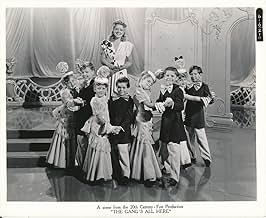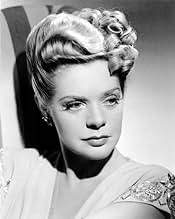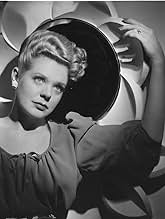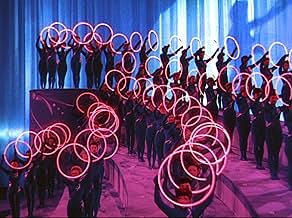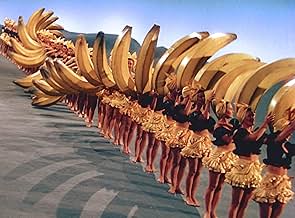ÉVALUATION IMDb
6,6/10
2,2 k
MA NOTE
Ajouter une intrigue dans votre langueA soldier falls for a chorus girl and then experiences trouble when he is posted to the Pacific.A soldier falls for a chorus girl and then experiences trouble when he is posted to the Pacific.A soldier falls for a chorus girl and then experiences trouble when he is posted to the Pacific.
- Nommé pour 1 oscar
- 2 victoires et 1 nomination au total
Benny Goodman and His Orchestra
- Benny Goodman's Orchestra
- (as Benny Goodman Orchestra)
Don Anderson
- Club New Yorker Patron
- (uncredited)
Leon Belasco
- Waiter
- (uncredited)
Brooks Benedict
- Club New Yorker Patron
- (uncredited)
Lee Bennett
- Club New Yorker Patron
- (uncredited)
William A. Boardway
- Club New Yorker Patron
- (uncredited)
Avis en vedette
It was called "The Girls He Left Behind", when first released in Britain in 1944. In this movie I think Busby Berkeley reached the pinnacle. It was his finest effort. Carmen Miranda, wearing that tutti frutty hat was a mouth-watering revelation; along with her ability to murder the English language. Roly poly Eugene Palette, trying to get the worrisome Edward Everett Horton's mind off his wife. Handing their hats to the hat-check girl, who was the lovely June Haver. (If you blinked you would have missed her). Alice Faye? A dream in Technicolour. James Ellison in the leading romantic role. Where was John Payne? He was the usual romantic lead in these Twentieth Century Fox musical capers of the early nineteen-forties.
Weak plot? Who the hell really cared! The Benny Goodman Orchestra; those songs, and the rich Technicolour, plus the Lanky Charlotte Greenwood, blindly reaching for the telephone and answering with the cat instead, brightened this teen-aged English boy's life in those wartime years of long ago. I have watched it on television more than once. The big question though. Why oh why, has it not been released on video or, better still, DVD? Can anyone explain?
Weak plot? Who the hell really cared! The Benny Goodman Orchestra; those songs, and the rich Technicolour, plus the Lanky Charlotte Greenwood, blindly reaching for the telephone and answering with the cat instead, brightened this teen-aged English boy's life in those wartime years of long ago. I have watched it on television more than once. The big question though. Why oh why, has it not been released on video or, better still, DVD? Can anyone explain?
20th Century Fox pulled out all the stops for this Technicolor musical, "The Gang's All Here," directed by Busby Berkeley. There is a song at least every few minutes, wonderful singing, dancing, and comedy galore, and an absolutely threadbare plot. The story is of no consequence - the music is the thing, along with Carmen Miranda's gaudily-costumed numbers and delightful butchering of the English language.
This film was made to bolster spirits during the war and to sell war bonds, which is dealt with in part of the plot. I can't imagine anyone walking out of the theater with anything but a smile on their face.
Alice Faye is lovely and sings beautifully in her contralto, her main number being "A Journey to a Star." Miranda's big number, of course, is the classic "The Lady in the Tutti Frutti Hat" with the fabulous illusion at the end. Charlotte Greenwood gets to dance in "The Jitters" and she, Edward Everett Horton, and Eugene Palette provide excellent support. Benny Goodman's band is a standout, and I've always been a sucker for Benny's smooth, relaxed singing voice. Busby Berkeley's numbers are spectacular, particularly the finale - but somehow, I can't see it being done on someone's lawn! I agree with one of the posters, these Fox musicals need to be packaged into a collection and put out on DVD. They're too much fun to miss.
This film was made to bolster spirits during the war and to sell war bonds, which is dealt with in part of the plot. I can't imagine anyone walking out of the theater with anything but a smile on their face.
Alice Faye is lovely and sings beautifully in her contralto, her main number being "A Journey to a Star." Miranda's big number, of course, is the classic "The Lady in the Tutti Frutti Hat" with the fabulous illusion at the end. Charlotte Greenwood gets to dance in "The Jitters" and she, Edward Everett Horton, and Eugene Palette provide excellent support. Benny Goodman's band is a standout, and I've always been a sucker for Benny's smooth, relaxed singing voice. Busby Berkeley's numbers are spectacular, particularly the finale - but somehow, I can't see it being done on someone's lawn! I agree with one of the posters, these Fox musicals need to be packaged into a collection and put out on DVD. They're too much fun to miss.
... from 20th Century Fox and director Busby Berkeley. The meager plot concerns Army sergeant on leave Andy Mason (James Ellison) who falls for nightclub performer Edie Allen (Alice Faye). The only problem is that Andy's already engaged to Vivian Potter (Sheila Ryan). Edie's flamboyant friend and co-worker Dorita (Carmen Miranda) tries to help, to mixed results. Also featuring Eugene Pallette, Edward Everett Horton, Phil Baker, Charlotte Greenwood, Tony De Marco, Dave Willock, Frank Faylen, June Haver and Jeanne Crain in their debuts, and Benny Goodman and His Orchestra.
The plot is naturally secondary to the musical numbers, several of which are bizarre, most notably "The Lady in the Tutti Frutti Hat", featuring chorus girls running around with giant bananas. Berkeley's camera moves around, under and above the action, shattering the pretense that these numbers are designed for a nightclub or theatrical audience, taking them strictly into the realm of cinema. The costumes are also eye-popping, even those worn in the non-musical scenes, and Miranda wears an assortment of outlandish hats. This marked the end of Alice Faye's star period. She had a cameo in the following year's Four Jills in a Jeep, and then a non-musical part in 1945's Fallen Angel, before entering into screen retirement for 17 years. The movie earned an Oscar nomination for Best Color Art Direction.
The plot is naturally secondary to the musical numbers, several of which are bizarre, most notably "The Lady in the Tutti Frutti Hat", featuring chorus girls running around with giant bananas. Berkeley's camera moves around, under and above the action, shattering the pretense that these numbers are designed for a nightclub or theatrical audience, taking them strictly into the realm of cinema. The costumes are also eye-popping, even those worn in the non-musical scenes, and Miranda wears an assortment of outlandish hats. This marked the end of Alice Faye's star period. She had a cameo in the following year's Four Jills in a Jeep, and then a non-musical part in 1945's Fallen Angel, before entering into screen retirement for 17 years. The movie earned an Oscar nomination for Best Color Art Direction.
"The Gang's All Here" is just pure entertainment in the old-school musical style (before Oklahoma!). There's essentially no plot, and what story there is, is full of plot-holes. It's propaganda dressed up in a musical. Don't get negative about this; music and dancing predominate and, of course, the cause is good. Made during WWII it almost subliminally reinforces home front practices during wartime, such as buying war bonds, and staying true to your man in uniform. A lot of this is probably lost to most viewers fifty years later. But think about it, and remember that when this movie was made, the Allied victory was not a sure thing.
And what about the music and dancing? Carmen Miranda in her tutti-frutti hat. Benny Goodman's swing band. Alice Faye. Busby Berkeley. If these people mean any thing to you, they are here in fine form.
And what about the music and dancing? Carmen Miranda in her tutti-frutti hat. Benny Goodman's swing band. Alice Faye. Busby Berkeley. If these people mean any thing to you, they are here in fine form.
Some of ALICE FAYE's close-ups in THE GANG'S ALL HERE convince me that Technicolor was made to show off the charms of certain actresses--as Fox well knew with such beauties as Betty Grable and Linda Darnell under contract. Faye's blue eyes get all misty-eyed when she sings a ballad--and when she's supported by someone like CARMEN MIRANDA for colorful contrast, well--you can bet it's a musical worth seeing and hearing.
In this case--mostly worth seeing because of Busby Berkeley's magical treatment of all the musical numbers. Who can ever forget CARMEN MIRANDA and all those waving bananas??? Or the kaleidoscope effect of several top numbers in an imaginative use of color and camera effects, the kind that only Berkeley was a master of.
The flimsy plot is strictly by the numbers and practically non-existent in a boy meets girl, boy loses girl, boy wins girl sort of way. JAMES ELLISON is a poor substitute for Fox's contract player John Payne, who must have been busy on another assignment when the cast was assembled. And PHIL BAKER is totally wasted.
But it's not too much of a distraction when the gaudy splashes of color, music and just downright fun provided by Faye, Miranda, Eugene Palette, Edward Everett Horton and Charlotte Greenwood come to the fore.
This is typical Fox escapism made for entertainment during World War II when the troops were all salivating over the Fox pin-up girls. Alice Faye is at her most attractive with her warm contralto voice showcased in a couple of hokey ballads and when she gazes heavenly toward some unseen spirit she practically melts the camera lens. She's luscious and so is the film.
And if you're a CARMEN MIRANDA fan, you can't afford to miss this one. Her "Tutti Frutti" number is a knockout and Benny Goodman and his band provide solid musical back-up. Just don't expect reality to butt in at any point during the silly plot.
Trivia note: That's ADELE JERGENS in the background of girls.
In this case--mostly worth seeing because of Busby Berkeley's magical treatment of all the musical numbers. Who can ever forget CARMEN MIRANDA and all those waving bananas??? Or the kaleidoscope effect of several top numbers in an imaginative use of color and camera effects, the kind that only Berkeley was a master of.
The flimsy plot is strictly by the numbers and practically non-existent in a boy meets girl, boy loses girl, boy wins girl sort of way. JAMES ELLISON is a poor substitute for Fox's contract player John Payne, who must have been busy on another assignment when the cast was assembled. And PHIL BAKER is totally wasted.
But it's not too much of a distraction when the gaudy splashes of color, music and just downright fun provided by Faye, Miranda, Eugene Palette, Edward Everett Horton and Charlotte Greenwood come to the fore.
This is typical Fox escapism made for entertainment during World War II when the troops were all salivating over the Fox pin-up girls. Alice Faye is at her most attractive with her warm contralto voice showcased in a couple of hokey ballads and when she gazes heavenly toward some unseen spirit she practically melts the camera lens. She's luscious and so is the film.
And if you're a CARMEN MIRANDA fan, you can't afford to miss this one. Her "Tutti Frutti" number is a knockout and Benny Goodman and his band provide solid musical back-up. Just don't expect reality to butt in at any point during the silly plot.
Trivia note: That's ADELE JERGENS in the background of girls.
Le saviez-vous
- AnecdotesThe production number "The Lady In The Tutti-Frutti Hat" ran into problems with the censors. The Hayes office at first considered the way the gigantic bananas were held in front of the dancers as being too "phallic". The problem was resolved by having the dancers hold the bananas at waist level rather than at hip level.
- GaffesIncorrectly regarded as goof: As the passengers disembark the ship within the first 3 minutes of the film, a series of mechanical-looking large shadows can be easily seen moving across the painted backdrop of buildings intended to be far in the distance. This is actually a stage set of a musical production, thus not filmed as a real scene.
- Citations
Phil Baker: Oh, Dorita, you remember Mr. Potter and Mr. Mason.
Dorita: Ah! I remember Mr. Potty. You are here to kick up some more heels, huh?
Peyton Potter: No!
Phil Baker: Mr. Potter wants you to come to his house this weekend.
Dorita: Ah-ah-ah, you naughty boy. You are what they call a fast-work man, yes?
- ConnexionsEdited into Myra Breckinridge (1970)
- Bandes originalesHail! Hail! The Gang's All Here!
(uncredited)
Music by Theodore Morse and Arthur Sullivan
Lyrics by Dolly Morse (as D.A. Esrom)
Sung by a chorus during the opening credits
Meilleurs choix
Connectez-vous pour évaluer et surveiller les recommandations personnalisées
- How long is The Gang's All Here?Propulsé par Alexa
Détails
- Date de sortie
- Pays d’origine
- Langues
- Aussi connu sous le nom de
- The Gang's All Here
- Lieux de tournage
- société de production
- Consultez plus de crédits d'entreprise sur IMDbPro
- Durée1 heure 43 minutes
- Couleur
- Rapport de forme
- 1.33 : 1
Contribuer à cette page
Suggérer une modification ou ajouter du contenu manquant

Lacune principale
By what name was Banana Split (1943) officially released in India in English?
Répondre

